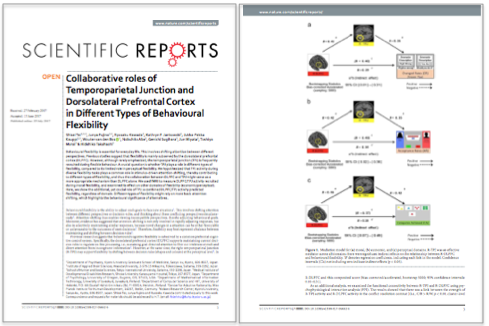阿部准教授らの論文が『Scientific Reports』に掲載されました
阿部修士准教授らの論文が、学術誌『Scientific Reports』に掲載されました。
本研究は柔軟な行動に関わる脳機能について、fMRIを用いて調べた研究です。これまでの研究では、柔軟な行動は、背外側前頭前野が主体的役割を担っていると考えられていました。本研究では、より柔軟な判断をするほど、背外側前頭前野と側頭頭頂接合部の活動が共に上昇している事を報告し、これらが視野(判断基準)の切替えを促進する可能性について推測しました。この研究はこころの未来研究センター連携MRI研究施設のMRIを用いて行われました。
 Tei S, Fujino J, Kawada R, Jankowski KF, Kauppi J, van den Bos W, Abe N, Sugihara G, Miyata J, Murai T, Takahashi H (2017). Collaborative roles of temporoparietal junction and dorsolateral prefrontal cortex in different types of behavioural flexibility. Scientific Reports 7 (1): 6415
Tei S, Fujino J, Kawada R, Jankowski KF, Kauppi J, van den Bos W, Abe N, Sugihara G, Miyata J, Murai T, Takahashi H (2017). Collaborative roles of temporoparietal junction and dorsolateral prefrontal cortex in different types of behavioural flexibility. Scientific Reports 7 (1): 6415http://www.nature.com/articles/s41598-017-06662-6 ※認証有り
○Abstract
Behavioural flexibility is essential for everyday life. This involves shifting attention between different perspectives. Previous studies suggest that flexibility is mainly subserved by the dorsolateral prefrontal cortex (DLPFC). However, although rarely emphasized, the temporoparietal junction (TPJ) is frequently recruited during flexible behaviour. A crucial question is whether TPJ plays a role in different types of flexibility, compared to its limited role in perceptual flexibility. We hypothesized that TPJ activity during diverse flexibility tasks plays a common role in stimulus-driven attention-shifting, thereby contributing to different types of flexibility, and thus the collaboration between DLPFC and TPJ might serve as a more appropriate mechanism than DLPFC alone. We used fMRI to measure DLPFC/TPJ activity recruited during moral flexibility, and examined its effect on other domains of flexibility (economic/perceptual). Here, we show the additional, yet crucial role of TPJ: a combined DLPFC/TPJ activity predicted flexibility, regardless of domain. Different types of flexibility might rely on more basic attention-shifting, which highlights the behavioural significance of alternatives.
2017/10/18